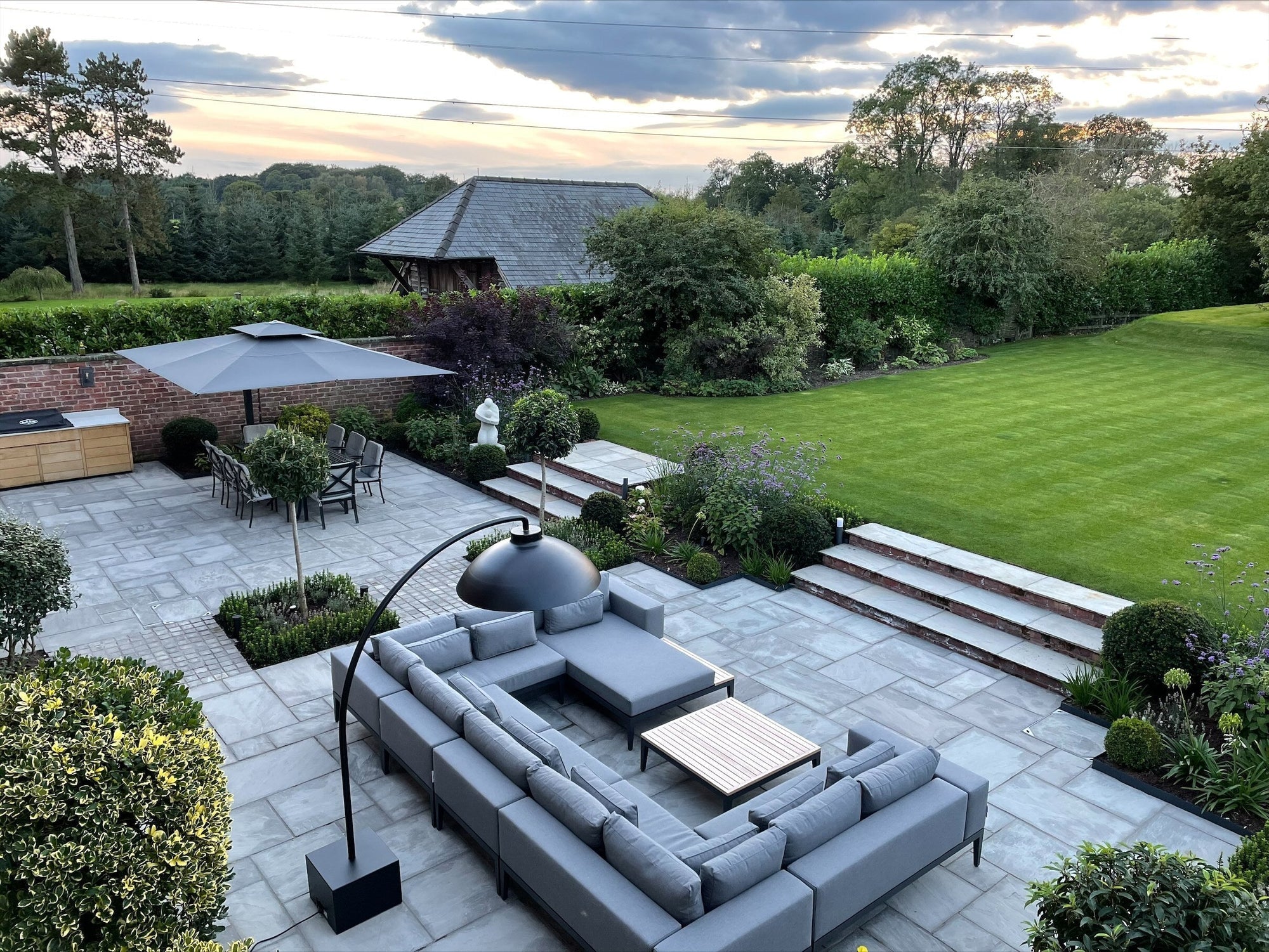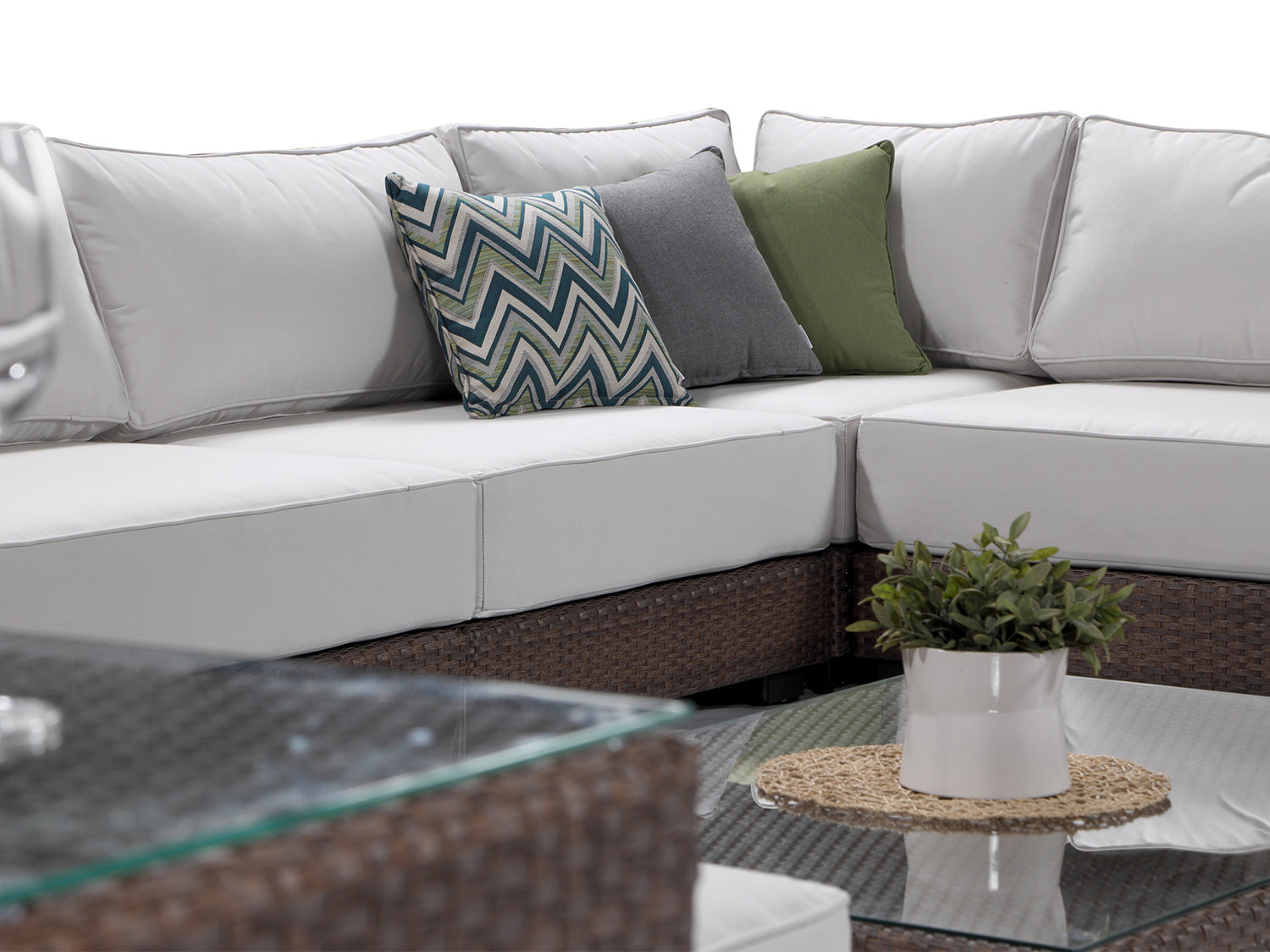high-end patio furniture. Whether it’s the warm glow of teak, the deep tones of mahogany, or the intricate texture of a rattan sofa set, these pieces are more than just functional. They’re an extension of your lifestyle and a reflection of your home’s beauty.
But even the most beautiful wooden furniture isn’t immune to the elements. Over time, exposure to the weather can take its toll. Don’t worry—this guide will help you breathe new life into your weathered outdoor furniture, so your space can stay the serene haven it’s meant to be.
Common outdoor wooden furniture materials

Before we delve into restoration techniques, let's look into the different materials that make luxury outdoor furniture so special:
-
-
Teak: Known for its high oil content, teak naturally resists rot, insects, and weather, gaining a stunning silver-grey patina over time.
-
Mahogany: With its rich, reddish-brown hues and impressive weather resistance, mahogany emanates warmth and opulence.
-
Ipe (Brazilian Walnut): This incredibly dense and durable wood is perfect for withstanding harsh conditions.
-
Eucalyptus: A sustainable hardwood with natural oils that deter decay and insects.
-
Rattan: Lightweight and resilient, rattan offers a distinct tropical charm. Synthetic alternatives, like PE rattan (resin wicker), are especially durable and weather-resistant.
-
Signs your outdoor wooden furniture needs restoring

How do you know when it’s time to give your outdoor wooden pieces some TLC? Look out for these signs:
-
Faded colours or dull, lifeless tones
-
Rough, splintery surfaces
-
Cracks, splits, or wobbly joints
-
Mould, mildew, or stubborn stains
-
Cushions that look tired or outdated
-
A general “drab” feeling in your outdoor setup
If you've noticed any of these signs, it's time to roll up your sleeves (or call in the professionals) for some restoration work!
6 tips for restoring weathered wood furniture
1. Sand your wood before refinishing
Sanding is often the first step in breathing new life into weathered wood. It removes the damaged outer layer, smooths out imperfections, and prepares the surface for treatment such as adding polish, lacquer, primer and paint.
Pro Tip: Always sand in the direction of the wood grain. Start with a coarser grit (around 80) and progressively move to finer grits (up to 220) for a smooth finish. If you’re able to, hire a professional or an orbit sander to make quick work of this!
2. Stain your wood
Staining can restore colour to faded wood or change its appearance entirely. For luxury outdoor furniture, consider using high-quality, weather-resistant stains that enhance the wood's natural grain - and opt for a staining colour that goes with your existing decor.
3. Seal your wood
Wood sealant comes in various shades and brands - but its main purpose is to provide extra protection against the elements (such as UV protection) - which is certainly needed in unpredictable British weather! We highly recommend an oil-based polyurethane sealer as they’re favoured for their durability, making them ideal for high-traffic surfaces that frequently encounter moisture and wear.
4. Try oiling your wooden furniture
Using wood oils helps make wooden furniture look clean and fresh. These oils are great at getting rid of tough build-ups of wax, dirt, or silicone, which matters when you use polishing products. This process doesn't just clean off all the gunk, it also keeps wood furniture looking fresh.
Besides cleaning, they protect the wood and create a layer that repels water, which helps prevent damage. They also bring out the wood's natural grain giving it a nice look that's more satin or shiny than glossy. This whole approach doesn't just clean the wood - it makes it healthier and better-looking overall.
Pro tip: Apply oil with a soft cloth, working it into the grain. Wipe off excess after 15 minutes to prevent a sticky surface.
5. Dry brush the furniture
While outdoor furniture can handle all kinds of weather year-round, it can be particularly tough if conditions are always wet, damp, or hot. Mould and mildew might start growing on the wood, which isn’t ideal.
To keep your outdoor furniture in good shape and stop these problems, you need to use a dry brush often (we recommend this as part of your routine garden maintenance). Dry brushing might not clean off everything, but it does a good job of removing these growths and other bits of dirt. It also smooths out the wood and gets it ready for more cleaning. Plus, dry brushing helps highlight the wood’s natural grain!
6. Change out your soft furnishing
Whilst this doesn’t fix the wooden furniture itself, it can marginally improve the overall appearance of your outdoor wooden furniture set-up.

Choosing Sunbrella® fabric for your garden furniture is an excellent way to blend the comfort and style of your indoor living spaces with the outdoors. Crafted from 100% solution-dyed acrylic fabric, it’s known for its durability and resistance to water, fading, mildew, and stains. This makes it ideal for withstanding adverse weather conditions while maintaining its appearance and functionality. Plus, it includes quick-dry foam inserts that allow your furniture to be ready for use just one hour after rain, ensuring minimal downtime.
How do you make old weathered wood look new again?
Start by cleaning the wood thoroughly to get rid of dirt, grime, and old stains. You can use a wood cleaner or a mix of warm water and mild soap. Apply it with a brush or sponge to reach the wood's grooves and textures. After cleaning, let the wood dry completely. Then, use a wood reviver according to the instructions on the label. This helps restore the wood's natural colour and prepares it for finishing. Once the wood is dry from the brightening, choose a finishing product.
For outdoor wood, a semi-transparent stain or a water-repellent finish is ideal for protection and enhancing its look. Apply it evenly for the best outcome. With some time and care, weathered wood can look like new again.
Can you bring weathered wood back to life?
Absolutely. The process usually includes cleaning, brightening, and sealing or staining the wood to protect it from the elements. Cleaning removes the grey, old layer on top, showing the healthier wood underneath. After cleaning, a wood brightener is used to balance the pH and bring back the wood's natural colour, getting it ready for a protective finish.
In order to keep your outdoor wooden furniture’s newly restored look, we’d recommend using winter covers to protect your garden furniture when it’s not in use during the colder months. This ensures they’re as protected from the elements as can be, so when you get back around to summertime, your furniture still looks pristine!
Can You Restore Wood Without Sanding?
If sanding feels like too much effort, there’s another way. Start by brushing off debris and cleaning the wood with a gentle cleaner. Once dry, apply a wood restorer to revive the colour and fill minor imperfections. It’s an easy, effective approach that’s kind to the existing finish.
Whether you're inspired to tackle restoration yourself, replace your outdoor furniture with something more durable or entrust your precious pieces to expert hands, the key is to act now before it gets worse. Read the Alexander Francis blog for more outdoor garden furniture advice, or contact us to speak to our friendly customer services team.



